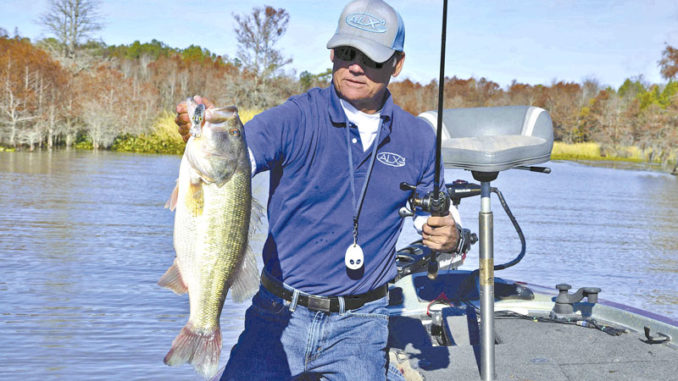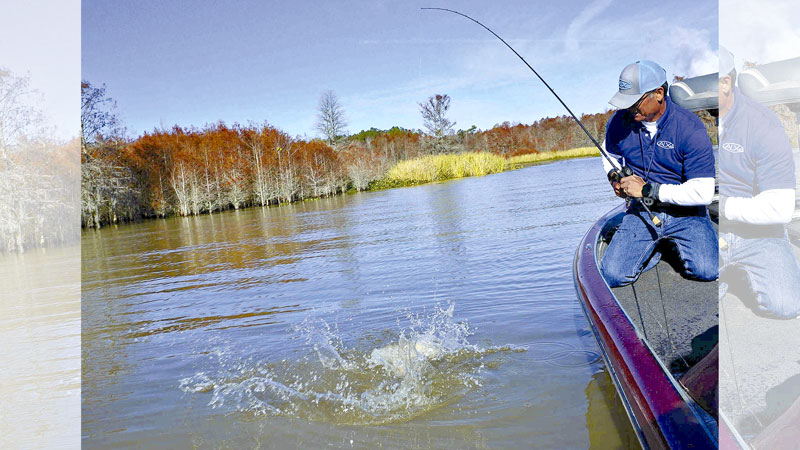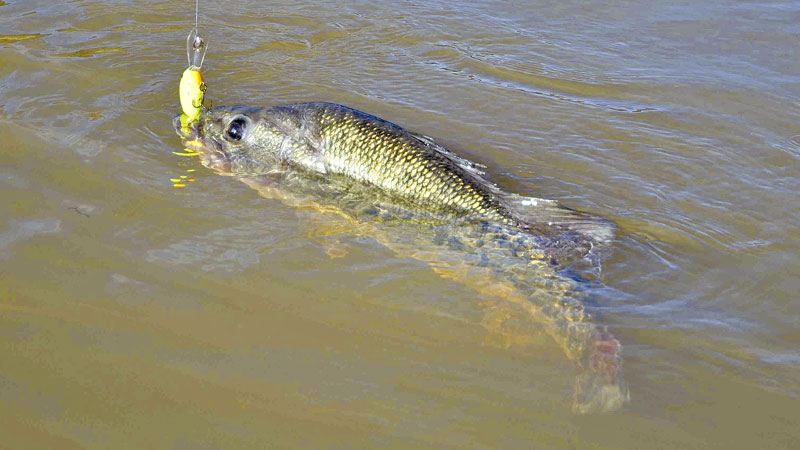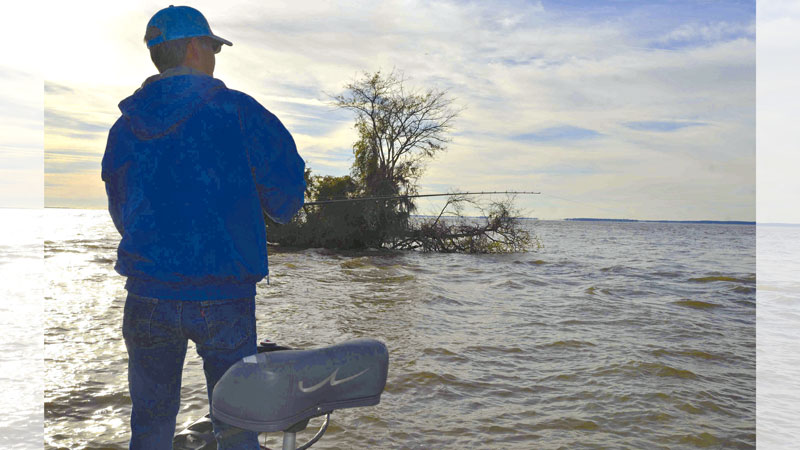
Stay close to deep water and go with big lures for February bass that are ready to put on the feed bag in the right situations.
February is the dead of winter across the northern hemisphere.
While it can be super chilly in the Carolinas, stellar fishing opportunities still exist in both freshwater and saltwater environments.
For serious bass fisherman, February is the prime time when many lunkers approaching double digits show up on the radar. And a large-profile lure is kryptonite to those big girls patrolling deep banks hoping for a biggie-sized meal.
No doubt, January and February bring temperature extremes to the Carolinas. But they don’t stop the feed. Fish don’t just wait for spring to arrive but continue to feed over the winter. That’s true whether they’re living in North Carolina’s High Rock Lake or South Carolina’s Santee Cooper lakes.
Pro bass anglers and guides must find feeding bass year-round. They have to figure out where to catch fish, and big fish, no matter what the conditions. Brett Mitchell is one such angler, a tournament fishermen and guide on the Santee Cooper lakes. He likes fishing in February because he typically finds famished, oversized fish in the mood to eat.
“Some of the biggest fish of the year are caught in January and February,” said Mitchell (803-379-7029). “We catch a lot of fish from 2 to 10 pounds out of the same spots this time of year.”
Even though the water is cold, fish are hungry and are preparing for what is to come over the next few months.
“The bass try to fatten up, because the spring spawn is coming, and it will take a lot out of them,” he said.

Look for stable water
Bass are predators and will move around throughout the year to places where they can find forage and feed. During the winter, the shallows get the full effect of the cold weather, which drives forage and predator fish into more temperature-stable waters. But they don’t have to be the super-deep waters of the middle of the lakes, either. Mitchell uses a strategy much different than he does during the spring, summer and fall.
“Basically, it is the opposite of what you would typically look for in spring (when) you are looking for shallow flats,” he said. “In winter, the fish will be abutted to deep banks, bluff banks and creeks with edges with water 5 to 6 feet deep along the bank. And they will not be far from water over 10 feet deep, either.”
Baitfish, bass and other predators stay close to deeper water so they can retreat to the warmer, deep areas. That’s because winter fluctuations in air temperatures can cause shallow-water temperatures to plummet into inhospitable ranges.
“Bass get totally focused on the shad during the winter. And they will be holding up along the deeper banks with even deeper water close by,” he said.
The deep, bluff banks offer the stability of deep water and available structure that baitfish will use to hide from predators. But February bass are voracious predators and eat plenty of shad over the winter. And that makes these places excellent areas for anglers to throw a selection of lures.
Don’t be afraid to upsize your lures
According to Mitchell, large bass congregate in these areas and look to feed on larger-sized baits.
“Larger bass typically look for larger forage fish in the winter. They eat bigger fish where they don’t have to feed as often,” he said.
Smaller bass will not generally travel with larger bass in winter for fear of being eaten. A 12-inch bass can be a juicy meal for a 20-inch largemouth.
Mitchell targets large February bass with swimbaits, spinnerbaits, lipless crankbaits, and other jumbo-sized lures.
“I don’t need something that goes 30 feet deep. I just look for baits with a larger profile to mimic larger baitfish,” he said.
Mitchell loves big swimbaits because they can be fished slowly. One of his favorites is the Keitech Fat Swing Impact. It has a perfect swimming appearance if retrieved slow or fast. During the winter, he is typically pulling these baits slowly. He also likes lipless baits like Rat-L-Traps and large, lipped crankbaits along these deep banks.

Don’t overlook brush in deep water
While he prefers deep banks with cover, he will also fish deep brush, and there’s no lack of such on his Santee Cooper lakes or in any other reservoir in the Carolinas, sunk either by state wildlife agencies as fish attractors or by die-hard bass or crappie anglers. These deep brush piles are perfect places to harbor shad, crappie and bluegill and they are ideal places for lunker bass to obtain a deluxe dinner.
When fishing brush, Mitchell uses combines two big lures with plenty of flash and vibration to entice bigger bass into striking.
“Spinnerbaits are wonderful winter lures for brush piles,” he said. “I like to use one with a large, willow-leaf blade with a swimbait as a trailer. It’s a huge profile, but it can be the perfect combination to use on deep brush and places with heavy cover in winter.”
Winter fishing isn’t for everybody, but for big bass, big lures can be the name of the game if fished in the right places.
“I may not get a ton of bites by using these large baits, but you will definitely get the bigger fish when they do,” he said.

Target moving water for winter bass
Bass fishing in winter can be tough, because the number of bites may not match the spring, but a dedicated angler can put a big stringer of bass together in a small chunk of real estate.
Productive winter spots are not as abundant as areas that hold fish the rest of the year, but some places are notably better, and places that have some moving water can create opportunities for bass to feed and anglers to catch them.
Lakes and reservoirs lack a significant level of moving water, but when it is present, fish will pile into those areas. Brett Mitchell of Fishing With Brett Guide Service takes full advantage of that situation.
“Running water is helpful,” Mitchell said. “Fish gang up at chokepoints. The current creates a feeding opportunity.”
In most reservoirs, running water is going to be associated with deeper water. Most places with running water are going to be in the river where it enters a lake, at a bottleneck near bridges or some kind of man-made canal system.
Mitchell is in a special situation on his home waters, Lake Marion and Lake Moultrie, which are connected by the 5-mile Diversion Canal.
“Current is easy to find on Santee due to the Diversion Canal, Rediversion Canal, and the two spillways,” he said.
The spillway gates are opened daily, which creates current throughout the connective canal system. These areas have current that create numerous chokepoints along the way in deep water.
Mitchell will look for chokepoints with cover and deep water to large, feeding bass in winter conditions.




Be the first to comment